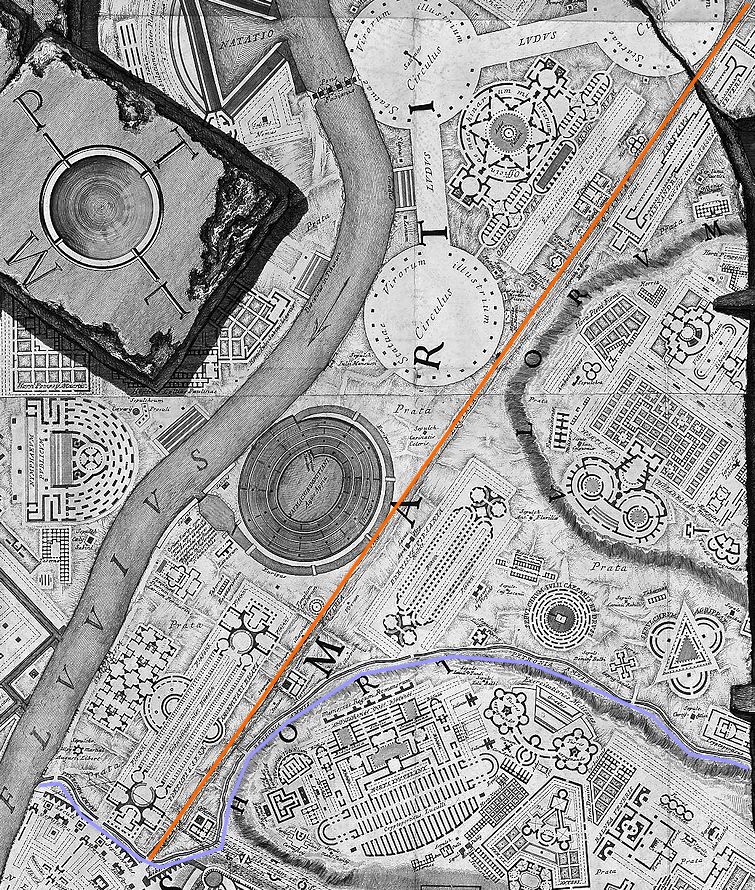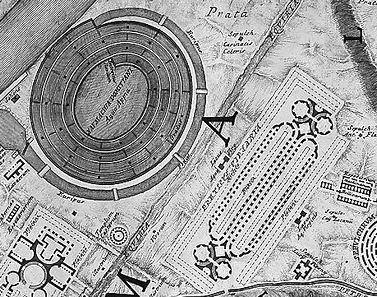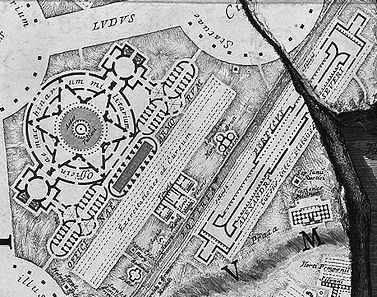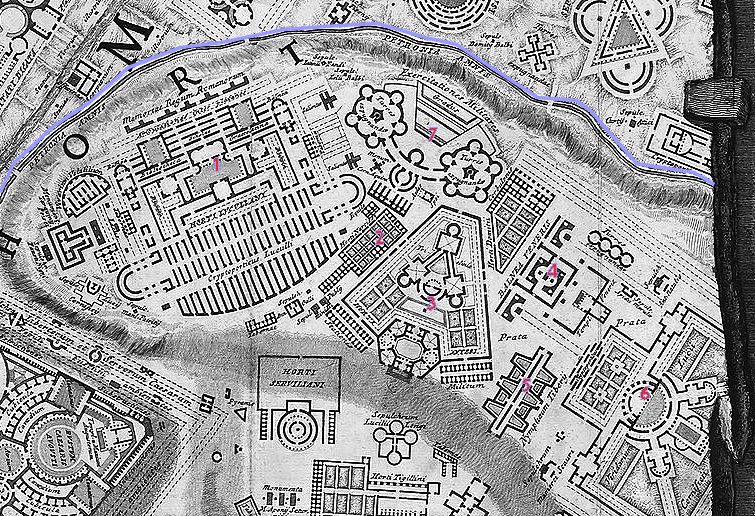Inside the Density of G. B. Piranesi's Ichnographia Campus Martius
love 1 a : the attraction, desire, or affection felt for a person who arouses delight or admiration or elicits tenderness, sympathetic interest, or benevolence 2 a : warm attachment, enthusiasm, or devotion 4 a : the attraction based on sexual desire
war 1 a (1) : a state of usu. open and declared armed hostile conflict between political units (2) : a period of armed conflict between political units 2 a : a state of hostility, conflict, opposition, or antagonism between mental, physical, social, or other forces
Within the northernmost region of the Ichnographia, Piranesi positions two of Rome's oldest topological features, the Equiria and the Petronia Amnis. The Equiria was ancient Rome's first festival in the form of horse races instituted by Romulus in honor of Mars, and the name Equiria applies to the festival as well the racecourse that Piranesi delineates. The Petronia Amnis was a stream that once came from a spring on the Quirinal and flowed through the Campus Martius. Although genuine historical phenomena, Piranesi's presentations of the Equiria and the Petronia Amnis are altogether false in terms of their geographic location within the Ichnographia. Both the course of the horse races and the course of the stream should be further south and within the Campus Martius proper, and this is yet another example where what seems to be a blatant mistake on Piranesi's part is actually a sign of ulterior, and usually double meanings. Judging in purely visual terms, Piranesi seems to have kept the Equiria and the Petronia Amnis in correct relationship to each other, and then, as a pair, lifted them out of their original context in order to refashion and reposition them in a new location. Essentially, the Equiria and the Petronia Amnis of the Ichnographia are reenactments of their former states.
In reenacting the Equiria and the Petronia Amnis, Piranesi executes each entity with their own respective theme, however, the two themes are in contrast to each other. This contrast is already evident in the Equiria's rigid straightness as opposed to the fluid meanderings of the Petronia Amnis, and it is indeed the antithetical natures of rigidity versus fluidity that Piranesi further develops within the two reenactments.
| |

The orange line indicates the course of the Equiria and the blue line indicates the course of the Petronia Amnis
|
Although the Equiria festival comprises two separate days of horse racing celebrated once a year, Piranesi transforms the race course into a grand civic allee. There are three enormous public porticos, a gigantic stadium for mock navel battles, a huge military factory, and two expansive parade grounds, plus a factory for making ballistas, a factory for making scorpions, and numerous smaller temples dedicated to various gods, especially those gods that patronize soldiers and sailors. Piranesi not only redesigns the original Equiria into ancient Rome's military headquarters, but he also creates an urban scale tribute to Mars, the war god himself, and thus the new Equiria, straight as an arrow from the very beginning, becomes the axis of war.
| |

the Naumachia Domitiani and the Porticus Vipsania
|

the Officinae machinarum militarium and the Porticus Alexandri Severi
|
Atop the bluffs along the south bank of the Petronia Amnis, Piranesi situates a series garden villas among a scattering of other building types. The planning of the villas individually is orderly, if not also symmetrical, yet, in relation to one another, the grouping of the villas appears completely disorganized. Once the names of the various buildings is understood, however, a distinctive pattern develops. The first and largest villa is the Horti Lucullani, the Gardens of L. Licinius Lucullus, which, in 46 AD "belonged to Valerius Asiaticus, but were coveted by Messalina, who compelled the owner to commit suicide."1 Messalena was the nymphomaniac wife of the emperor Claudius. Next to the Horti Lucullani is the plain and simple Horti Narcissi; Narcissus was the name of the freedman of Claudius by whose orders Messalena was put to death. Next to the Horti Narcissi is the triangular Horti Anteri. There was no real garden of Anteri in ancient Rome, but there was such a thing as an anteros, which is an avenger of slighted love, or, in this case, love triangles. Then there is a bath complex in honor of Venus, the love goddess herself, and then a nympheum named for Tiberius, an emperor known for his fondness of pornography. And at the edge of the Ichnographia , there is the Viridarium Lucii Cornificii, a pleasure garden with two building extensions clearly phallic in plan. Finally, among these structures of love and lust are two Turres expugnandae, military defense towers whose plans no doubt represent substantial erections.
Piranesi's reenactment of the Equiria and the Petronia Amnis seems to simlpy say that all is fair in ancient Rome's fluid love and rigid war.
1. Samuel Ball Platner, The Topology and Monuments of Ancient Rome (Boston: Allyn and Bacon, 1904).
| |

1. Horti Lucullani 2. Horti Narcissi 3. Horti Anteri 4. Balnea Veneris 5. Nymphaum Tiberij 6. Viridarium Lucii Cornificii 7. Turres expugnandae
The blue line indicates the course of the Petronia Amnis.
|
| |
1999.12.09 11:06
quick response, good trip
Hi Kelly,
Have a good trip. I envy your being able to do such studies/implementations in such an interesting place.
I know of the Metabolists, but not their writing/ideas per say. More recently I've read what Isozaki says in retrospect regarding the Metabolist movement, and there he actually raises the issue of destruction not having been part of the original Metabolist credo, although, as he now sees it, destruction should have been a part of it. What I most like about metabolism as a process is that there has to be both creation and destruction in order for the process to work (otherwise none of us could even literally live). Moreover, I see humanity today demonstrating a high (and rising) degree of metabolic imagination.
I am a registered architect, but I do not 'practice' or teach in any orthodox fashion. The last three years I've devoted to creating www.quondam.com as a (actually the first and so far only) virtual museum of architecture. Essentially, I'm continually designing and directing a virtual building, and, according to the feedback I receive, and judging from what my web stats indicate, my 'museum' is viewed in architecture schools all over the globe. Besides that, I like to tell people that I'm retired.
I'll try to write you some more while you're in Vietnam, hoping the email won't be too much of a distraction.
Steve
|



